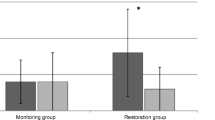Abstract
Objectives
The aim of this study was to investigate if a minimally invasive oral health package with the use of atraumatic restorative treatment (ART) or a conventional restorative technique (CT) would result in any perceived benefit from the patients’ perspective and if there would be any difference between the two treatment groups.
Materials and Methods
In this randomised clinical trial, 99 independently living older adults (65–90 years) with carious lesions were randomly allocated to receive either ART or conventional restorations using minimally invasive/intervention dentistry (MID) principles. Patients completed an Oral Health Impact Profile (OHIP)-14 questionnaire before and 2 months after treatment. They were also asked to complete a global transition question about their oral health after treatment.
Results
At baseline, the mean OHIP-14 scores recorded were 7.34 (ART) and 7.44 (CT). Two months after treatment intervention, 90 patients answered the OHIP-14 and the mean scores were 7.23 (not significant (n.s.)) and 10.38 (n.s.) for the ART and CT groups, respectively. Overall, 75.5 % of patients stated that their oral health was better compared to the beginning of treatment.
Conclusions
Although not shown by the OHIP-14, patients perceived an improvement in their overall oral status after treatment, as demonstrated by the global transition ratings in both groups.
Clinical relevance
Dental treatment using minimally invasive techniques might be a good alternative to treat older individuals, and it can improve their oral health both objectively and subjectively.



Similar content being viewed by others
References
Petersen P, Kandelman D, Arpin S, Ogawa H (2010) Global oral health of older people—call for public health action. Community Dent Health 27:257–267
Chalmers JM (2006) Minimal intervention dentistry: part 1. Strategies for addressing the new caries challenge in older patients. J Can Dent Assoc 72:427–433
Allen PF, Thomason JM, Jepson NJ, Nohl F, Smith DG, Ellis J (2006) A randomized controlled trial of implant-retained mandibular overdentures. J Dent Res 85:547–551
Reissmann DR, Remmler A, John MT, Schierz O, Hirsch C (2012) Impact of response shift on the assessment of treatment effects using the Oral Health Impact Profile. Eur J Oral Sci 120:520–525
Da Mata C, Allen PF, Cronin M, O’Mahony D, McKenna G, Woods N (2014) Cost-effectiveness of ART restorations in elderly adults: a randomized clinical trial. Community Dent Oral Epidemiol 42:79–87
Locker D, Jokovic A, Clarke M (2004) Assessing the responsiveness of measures of oral health-related quality of life. Community Dent Oral Epidemiol 32:10–18
Slade GD (1997) Derivation and validation of a short-form oral health impact profile. Community Dent Oral Epidemiol 25:284–290
Ellis JS, Pelekis ND, Thomason JM (2007) Conventional rehabilitation of edentulous patients: the impact on oral health-related quality of life and patient satisfaction. J Prosthodont 16:37–42
Szentpetery AG, John MT, Slade GD, Setz JM (2005) Problems reported by patients before and after prosthodontic treatment. Int J Prosthodont 18:124–131
Ozhayat EB, Gotfredsen K (2012) Effect of treatment with fixed and removable dental prostheses. An oral health-related quality of life study. J Oral Rehabil 39:28–36
Slade GD, Spencer AJ (1994) Development and evaluation of the Oral Health Impact Profile. Community Dent Health 11:3–11
Larsson P, List T, Lundstrom I, Marcusson A, Ohrbach R (2004) Reliability and validity of a Swedish version of the Oral Health Impact Profile (OHIP-S). Acta Odontol Scand 62:147–152
Slade GD, Sanders AE (2011) The paradox of better subjective oral health in older age. J Dent Res 90:1279–1285
Ajwani S, Mattila KJ, Tilvis RS, Ainamo A (2003) Periodontal disease and mortality in an aged population. Spec Care Dent 23:125–130
Ethical standards
The study protocol was approved by the Cork Dental School and Hospital Ethics Committee (ECM 5 (4) 02/09/08) and was therefore in accordance with the Declaration of Helsinki. All patients gave their informed consent prior to the beginning of the study.
Conflicts of interest
The authors acknowledge the financial assistance provided for this study by the Health Research Board, Ireland (Grant number HRAPOR/2010/154). The authors declare that they have no other conflicts of interest.
Author information
Authors and Affiliations
Corresponding author
Rights and permissions
About this article
Cite this article
da Mata, C., Cronin, M., O’Mahony, D. et al. Subjective impact of minimally invasive dentistry in the oral health of older patients. Clin Oral Invest 19, 681–687 (2015). https://doi.org/10.1007/s00784-014-1290-6
Received:
Accepted:
Published:
Issue Date:
DOI: https://doi.org/10.1007/s00784-014-1290-6




